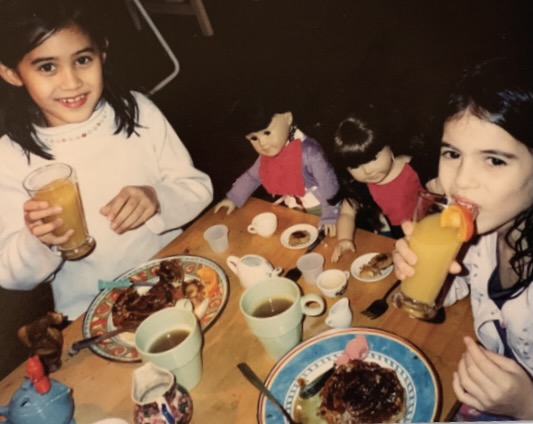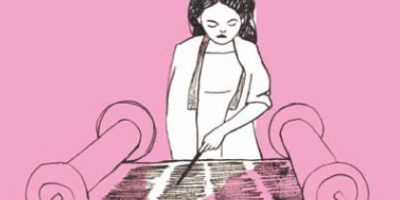
An office confessional: getting real about childhood dolls.
I will be the first to admit that I love dolls. And though this love was planted in my childhood, it bloomed even more in my adulthood. I took a class in Girlhood Studies (a smaller field within Gender and Women’s Studies) and started to think about how dolls often weave girls and women together through space and time; when women think about dolls, we remember what it was like to be girls. And while playing with dolls, children practice adulting: decision-making, world-building and storytelling, problem-solving and emotional processing. Though I appreciate all dolls, I definitely have a bias for American Girl Dolls. It started with a realization of my childhood dream of visiting the iconic American Girl Doll cafe, with cocktails involved. And then came the surge of American Girl Dolls in pop culture (making American Girl Doll memes was part of Lilith’s coping toolbox the summer that Roe was overturned). I couldn’t stop thinking about my precious childhood companions and their capacity to be feminist tools.
American Girl was founded in 1986 and initially released a handful of dolls with historically accurate outfits, accessories, and accompanying books told from the points of views of the girls. This is what makes American Girl so unique and groundbreaking. Jamie Cygielman, the General Manager of American Girl, told Lilith that’s their mission: “From the start, American Girl has been focused on helping girls grow up with courage, confidence, and strength of character. As a brand rooted in story, each of our beloved heroines has helped to create a sense of connection and community among our fans…” she said.
Experts have more complex opinions about the phenomenon: “Part of what is going on is class anxiety…” wrote Lizzie Feidelson this fall in the New Yorker. “The dolls cost enough to be inaccessible to many American girls (over $60 in 1986). But the brand has always been marketed to middle-class consumers.” Feidelson attributes millennials’ fixation with the dolls to class aspiration and anxiety and an ability to “remix” those historical details, but ends with this reminder about what dolls represent to their owners, now grown-up: “Our early childhoods preceded social media …by college, we’d immigrated to the land of the online, and could never return home,” she writes. “As we logged on, [the dolls] stayed behind.” Over time, American Girl has welcomed four dolls with Jewish backgrounds, including Rebecca, a Russian Jewish girl fighting assimilation and exploring Yiddish theater as she grows up in New York during the early 20th century, and Nicki and Isabel, a Riot grrrl and high femme twin duo coming of age in Seattle during the tech boom. The company published books with guidance aimed at girls, most notably the iconic “The Care and Keeping of You” series about puberty that is a kind of Torah (or at least, Our Bodies, Ourselves) for girls who grew up in the early 2000s. In the post Greta Gerwig-Barbie world, dolls are back on our radar, so I asked a few questions at a Lilith lunchtime conversation. Here are some answers, lightly edited.
ALEXA HULSE: What is everyone’s first memory of American Girl Dolls?
SIVAN ELLMAN: My older sister got Molly when she was six or seven and I was three or four, around 2005. It was a rite of passage to get an American Girl Doll, to be responsible enough to get one.
ARIELLE SILVER-WILLNER: My first doll was also Molly when I was six or seven (around 2003). My grandparents handed me the catalog. “We’re getting your cousins dolls, these dolls that all the girls are getting. Do you want one for your birthday?” I pointed to the first one I saw and it was Molly.
GWEN TUCKER: My first American Girl Doll was a look-like-you doll which was very exciting to me, I was six or seven.
SARAH SELTZER: In the early 90s American Girl started getting big. I had a very close best friend, our birthdays were two weeks apart and for our eight or ninth birthday we both got Samantha. A couple years later, we both got Kirsten. My whole life was dolls. I had dozens of Barbies, I collected Madame Alexander dolls, and paper dolls were huge with me and my friends. We played very hard with them, we didn’t keep them on display. I was the only girl grandchild on both sides, so all the dolls I had were because of that. The older women in my family liked to dress me up and give me dolls to play with and I was into it. Now, we call it “high femme,” but at the time it was just “I like dolls!”
REBECCA KATZ: Sarah and I are five years apart but we played with the same early-to-mid-90s American Girl Dolls. I got Samantha as my first one; it was a BIG deal, it was like two birthdays and Hanukkahs combined. I knew about the dolls because a magazine was sent to my house and I spent hours looking through it. This was the first time I was aware of money in some ways. One of my friends had every single doll, and I was so jealous of her.
ARIELLE: Yes, a new doll was a Very Special Occasion gift for most of my friends and me. I find it ironic that many of the backstories have to do with poverty—Kit’s family is struggling through the Great Depression; Molly’s family has to limit their butter and sugar use due to wartime rations; Addy and her mom are escaping slavery—and yet, only people who could drop a hundred bucks could actually buy the dolls.
SUSAN WEIDMAN SCHNEIDER: You all have seen that early Lilith piece about American Girl Dolls. We had interns who were first-year college students before any of the Jewish dolls came out. They wrote a letter to the American Girl company asking “why don’t you have any Jewish dolls?” The company responded saying they were creating one and sent each intern a doll that they identified with; that was an early spur to creating more diverse dolls.
ALEXA: When I first read that Lilith article I did some digging into American Girl Doll history and found out that the first Jewish doll came out two years after the interns wrote to them. It is possible that Lilith played a big part in that.
SUSAN: Our interns felt that they did.
ALEXA: How did dolls inform your sense of what it means to be a girl and a woman?
SIVAN: I think the sentiment of “getting dolled up” really stuck with me. You could dress them up and get their ears pierced and get their hair done. Adorning them informed how I adorned myself. It set a standard of beauty for me in my tween years.
SUSAN: It’s so interesting to think of this inversion. Usually, you dress the doll up. But in your case, the doll was a model for you.
SARAH: The dolls and their clothes are so beautiful and you are meant to play with them. American Girl Doll kind of combines a fashion doll with the beauty and innocence of a more classic doll. It hits a sweet spot. Barbie is a grown-up doll, and there have always been baby dolls, but American Girl Doll represents the girls in between.
ARIELLE: For me, there was never a projection of myself onto the dolls; it was about nurturing and caretaking. More than anything, I wanted a baby sister and that is what my dolls were for me. I would try to convince people they were real, like these were my babies and I had to take care of them. It was this other aspect of stereotypical femininity, motherhood and caretaking. But the other big part of it for me was that my mom and I read all of the American Girl books together. They had their stories—and I was always making up stories with my friends.
SARAH: We had multiweek games where we made up stories. We would leave out all the accessories that we’d been using, and then pick up the plotline at the next playdate. It led right to fiction writing.
SUSAN: There’s a difference between the fantasy and the caregiving aspect. I wonder if there’s a difference because of the very passivity of the dolls that look like baby dolls.
SARAH: It’s related. I also had baby dolls when I was younger, and I took care of them and put them in the cradles, but that evolved into the imaginary stuff.
GWEN: One phenomenon in my childhood was American Girl YouTube. There were teenage girls on the internet who would have massive dollhouses and like twenty dolls. This one girl made a six-season scripted show with American Girl Dolls, incredibly intricate projects. That inspired me; my friends and I even made a couple scripted episodes of a show with our dolls. The evolution from having dolls and telling stories in your room and then having a broader audience and being well-received by young women on the internet is fascinating to me.
SUSAN: We have the good face of dolls and the bad face of dolls. The opportunities for creative thinking is the good part of it and the bad part of it is needing to lose two ribs to look like Barbie.
REBECCA: Another good aspect of it is that American Girl Dolls show that girls are worthy of time and study; that girls—not just women, but girls and teens—are unquestionable protagonists that have the right to have their own stories and lives and agency.
SARAH: Even the idea of girls being centered in history is so important. There is women’s history and Black history and Jewish history, but kids are left out, and girls even more so. The idea of making a young girl the centerpiece of every historical era is radical and different.
ARIELLE: Reading the books was the first time that I was learning about a lot of these historical events and I was learning about them, first and foremost, from a girl’s perspective.
SIVAN: I also remember the book The Care and Keeping of You, which is all about puberty and how to groom yourself, how to put a tampon in, etc. That book is a core memory, it felt like the Bible.
REBECCA: Did you find this book exciting and informational or did it feel like it was teaching you how to perform womanhood?
SIVAN: It felt very secretive, it’s like how now you hide your vibrator in your sock drawer. You hid the book because you didn’t want someone to find it or you would be exposed.
ALEXA: It also felt like a secret to me but in a different way. I was in fourth or fifth grade when I first read it and I didn’t want to share it with my younger sister; there were so many things I had to share growing up, but this book felt like precious knowledge and I wanted it to be mine.
ARIELLE: Also because it came from the American Girl universe it was less daunting than other books about puberty. I trusted them.
REBECCA: Now I am curious how many people who are pioneering Girlhood Studies had American Girl Dolls. What’s the connection between American Girl Doll and taking girlhood seriously?
ALEXA: What Jewish American Girl Doll storylines would you like to see?
ARIELLE: An American [Non-Binary] Doll who is a Jewish activist!
SARAH: A second-wave-feminist who grew up in suburbia and gets radicalized in college!
REBECCA: This would be an International Girl Doll, but I would love to see a doll about the Jewish community in Iraq before the Farhud.
ALEXA: I want to see one who is a Lilith subscriber!
Alexa Hulse (she/they) is a senior at Hollins University, and was a Lilith intern from 2021–2023. Her writing is at Lilith Online and in Salt and Honey, the anthology from jGirls+ Magazine.






